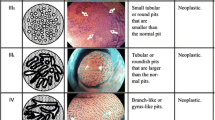Abstract
Background
Colorectal cancer arises from precancerous lesions, primarily adenomatous and serrated polyps. Some polyps pose significant technical endoscopic challenges due to their size, location, and/or morphology. A standardized protocol for documentation and management of these polyps can optimize clinical outcomes.
Methods
A Quality Improvement project compared patients with a complex polyp (non-pedunculated, > 2 cm), for 12 months prior and 12 months after protocol introduction. Documentation and polyp management details were compared pre- and post-implementation using the Chi-square test.
Results
69 patients were diagnosed with complex polyps prior to the protocol introduction and 72 after. 79% (112/141) of patients underwent endoscopic mucosal resections (EMR) locally, and 14.9% (21/141) underwent surgery locally. After protocol introduction, there was significant improvement in documentation of suspicious appearing polyps (21.7% to 47.2%, P = 0.001), luminal circumference (14.5% to 34.7%, P = 0.005), and management plans (87.0% to 97.2%, P = 0.023); other elements of documentation were similar. The number of patients reviewed at multidisciplinary conference (MDC) increased from 1 to 61% (P < 0.005). Patients rebooked in a 1 h endoscopy time slot increased from 19 to 58% (P < 0.005), as did specific consent for EMR from 22 to 57% (P < 0.005). Among patients with polyps 3 cm or greater (23 pre, 36 post), MDC review increased from 4 to 67% (P < 0.005), primary polypectomy decreased from 72 to 23% (P = 0.001), patients rebooked in a double endoscopy slot increased from 33 to 75% (P = 0.005), and specific consent increased from 39 to 75% (P = 0.014). There were less polyp recurrences (12/42 pre and 1/50 post) among the post-protocol cohort (P < 0.001).
Conclusions
The introduction of a formalized protocol for complex polyp adjudication and management has led to improved documentation, multidisciplinary discussion, and optimal complex polyp management with dedicated time for EMR, particularly for polyps over 3 cm. There is room for improvement, and this can be approached in a collaborative manner.



Similar content being viewed by others
Data availability
The data for this study is available upon request from the corresponding author.
References
Lee S (n.d.) Colorectal cancer statistics. Canadian Cancer Society. https://cancer.ca/en/cancer-information/cancer-types/colorectal/statistics. Accessed 24 Dec 2022
Canadian Task Force on Preventive Health Care (2016) Recommendations on screening for colorectal cancer in primary care. CMAJ 188(5):340–348
Angarita FA, Feinberg AE, Feinberg SM et al (2018) Management of complex polyps of the colon and rectum. Int J Colorectal Dis 33:115–129
Waye JD (2005) Advanced polypectomy. Gastrointest Endosc Clin N Am 15:733–756
Gallegos-Orozco JF, Gurudu SR (2010) Complex colon polypectomy. J Gastroenterol Hepatol 6:375–382
Rutter MD, Chattree A, Barbour JA et al (2015) British Society of Gastroenterology/Association of Coloproctologists of Great Britain and Ireland guidelines for the management of large non-pedunculated colorectal polyps. Gut 64:1–27
Alberta Innovates (2022) ARECCI - The Alberta Innovates ethics screening tool. https://arecci.albertainnovates.ca/. Accessed 24 Dec 2022
Group ECR (2005) Update on the Paris classification of superficial neoplastic lesions in the digestive tract. Endoscopy 37:570–578
Cancer Care Ontario (2019) Management of complex polyps: regional-level guidance. Cancer Care Ontario, Toronto
Thiruvengadam SS, Fung BM, Barakat MT, Tabibian JH (2022) Endoscopic mucosal resection: best practices for gastrointestinal endoscopists. Gastroenterol Hepatol 18:133–144
Gaudioso C, Sykes A, Whalen PE, Attwood KM, Masika MM, Demmy TL, Dexter EU, Hennon MW, Picone AL, Yendamuri SS, Nwogu CE (2022) Impact of a thoracic multidisciplinary conference on lung cancer outcomes. Ann Thorac Surg 113:392–398. https://doi.org/10.1016/j.athoracsur.2021.03.017
Snelgrove RC, Subendran J, Jhaveri K, Thipphavong S, Cummings B, Brierley J, Kirsch R, Kennedy ED (2015) Effect of multidisciplinary cancer conference on treatment plan for patients with primary rectal cancer. Dis Colon Rectum 58:653–658. https://doi.org/10.1097/dcr.0000000000000390
Kedia P, Waye JD (2011) Routine and advanced polypectomy techniques. Curr Gastroenterol Rep 13:506. https://doi.org/10.1007/s11894-011-0210-z
Hattori S, Iwatate M, Sano W, Hasuike N, Kosaka H, Ikumoto T, Kotaka M, Ichiyanagi A, Ebisutani C, Hisano Y, Fujimori T, Sano Y (2014) Narrow-band imaging observation of colorectal lesions using NICE classification to avoid discarding significant lesions. World J Gastrointest Endosc 6:600–605. https://doi.org/10.4253/wjge.v6.i12.600
Sano Y, Tanaka S, Kudo S, Saito S, Matsuda T, Wada Y, Fujii T, Ikematsu H, Uraoka T, Kobayashi N, Nakamura H, Hotta K, Horimatsu T, Sakamoto N, Fu K, Tsuruta O, Kawano H, Kashida H, Takeuchi Y, Machida H, Kusaka T, Yoshida N, Hirata I, Terai T, Yamano H, Kaneko K, Nakajima T, Sakamoto T, Yamaguchi Y, Tamai N, Nakano N, Hayashi N, Oka S, Iwatate M, Ishikawa H, Murakami Y, Yoshida S, Saito Y (2016) Narrow-band imaging (NBI) magnifying endoscopic classification of colorectal tumors proposed by the Japan NBI Expert Team. Digest Endosc 28:526–533. https://doi.org/10.1111/den.12644
Funding
Support for this quality improvement project was received from the Vernon Jubilee Hospital Physician Society, a branch of the Doctors of BC Facility Engagement Initiative.
Author information
Authors and Affiliations
Corresponding author
Ethics declarations
Disclosures
Lina Cadili, Michael Horkoff, Scott Ainslie, Brian Chai, Jeffrey S. Demetrick, Karl Langer, Kevin Wiseman and Hamish Hwang have no conflicts of interest or financial ties to disclose.
Additional information
Publisher's Note
Springer Nature remains neutral with regard to jurisdictional claims in published maps and institutional affiliations.
Rights and permissions
Springer Nature or its licensor (e.g. a society or other partner) holds exclusive rights to this article under a publishing agreement with the author(s) or other rightsholder(s); author self-archiving of the accepted manuscript version of this article is solely governed by the terms of such publishing agreement and applicable law.
About this article
Cite this article
Cadili, L., Horkoff, M., Ainslie, S. et al. Improving the management and outcomes of complex non-pedunculated colorectal polyps at a regional hospital in British Columbia. Surg Endosc 38, 1257–1263 (2024). https://doi.org/10.1007/s00464-023-10631-8
Received:
Accepted:
Published:
Issue Date:
DOI: https://doi.org/10.1007/s00464-023-10631-8




